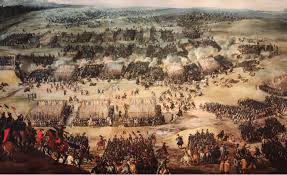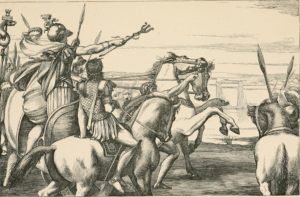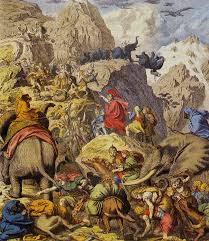This article deals with the initial Roman Expansion within the limits of Italy as discussing the entire Roman Expansion would be too elaborate a task.
At first, Rome was just one, a small city-state in an area of Latin-speaking people (called Latium), on the west side of Italy’s peninsula. Rome, as a monarchy (founded, according to legend, in 753 B.C.), couldn’t even keep foreign powers from ruling it. It started gaining strength from about 510 B.C. (when the Romans threw out their last king) until the middle of the 3rd century B.C.

During this, the early Republican period, Rome made and broke strategic treaties with neighboring groups in order to help her conquer other city-states. In the end, after revising her battle tactics, weapons, and legions, Rome emerged as the undisputed leader of Italy. This quick look at the growth of Rome names the events leading to Rome’s domination over the peninsula.
In the legendary beginning of its history, Rome was ruled by 7 kings.
1.The first was Romulus, whose ancestry is traced to Trojan (War) prince Aeneas.
2.The next king was a Sabine (a region of Latium northeast of Rome), Numa Pompilius.
3.The third king was a Roman, Tullus Hostilius, who welcomed the Albans into Rome.
4.The fourth king was Numa’s grandson, Ancus Martius.
After he came the 3 Etruscan kings,
5.Tarquinius Priscus
6.his son-in-law Servius Tullius, and
7.Tarquin’s son, the last king of Rome, known as Tarquinius Superbus or Tarquin the Proud.
Latin Alliances for Ancient Roman Expansion
The Romans dethroned their Etruscan king and his relatives peacefully, but they had to fight to keep them out. By the time the Romans had conquered the Etruscan Porsenna, at Aricia, even the threat of Etruscan rule of the Romans had ended.

Then the Latin city-states except Rome came together against Rome. While they fought each other, the Latin allies suffered attacks from the mountain tribes. These resided on the east of the Apennines, a long mountain range that divides Italy into an eastern and western side. The mountain tribes are presumed to have been attacking because they needed more arable land.
Rome and the Latins Make Treaties
The Latins had no extra land to give the mountain tribes, so, in about 493 B.C., the Latins this time including Rome signed a mutual defense treaty that is called Foedus Cassianum, which is Latin for ‘Cassian Treaty’.
A few years later, in about 486 B.C., the Romans made a treaty with one of the mountain peoples, the Hernici, who lived between the Volsci and the Aequi, who were other eastern mountain tribes. Bound to Rome by separate treaties, the league of Latin city-states, the Hernici, and Rome defeated the Volsci. Rome then settled Latins and Romans as farmer/landowners in the territory.
The growth of Rome as part of Roman expansion:
Rome Expands Into Veii
In 405 B.C., the Romans began an unprovoked 10-year struggle to annex the Etruscan city of Veii. The other Etruscan cities failed to rally to the defense of Veii in a timely manner. By the time some of the Etruscan league of cities came, they were blocked. Camillus led the Roman and allied troops into victory in Veii, where they slaughtered some Etruscans, sold others into slavery, and added land to the Roman territory, much of it given to Rome’s plebeian poor.
Temporary Setback to the Growth of Rome
The Sack of the Gauls
In the 4th century B.C., Italy was conquered by the Gauls. Although Rome survived, thanks in part to the noisily famous Capitoline geese, the Romans’ defeat at the Battle of the Allia remained a sore spot throughout history. The Gauls left Rome only after they were given a lot of gold. Then they gradually settled down, and some made alliances with Rome.
Growth of Rome Resumes
Rome Dominates Central Italy
Rome’s loss made other Italic cities more aggressive, but the Romans didn’t just take light. They learned from their mistakes, improved their military, and fought off Etruscans, Aequi, and Volsci during the decade between 390 and 380.

In 360, the Hernici (Rome’s former non-Latin league ally who had helped defeat the Volsci), and the cities of Praeneste and Tibur allied themselves against Rome, unsuccessfully: Rome added them to its territory.
Rome forced a new treaty on her Latin allies making Rome dominant. The Latin league, with Rome at its head, then defeated the league of Etruscan cities.
In the middle of the 4th century B.C., Rome turned towards the south, to Campania (where Pompeii, Mt. Vesuvius and Naples are located) and the Samnites. Although it took until the beginning of the third century, Rome did defeat the Samnites and annexed the rest of central Italy.
Rome Annexes Southern Italy
Finally, Rome looked to southern Italy and fought King Pyrrhus of Epirus. While Pyrrhus won 2 battles, both sides fared badly. Rome had an almost inexhaustible supply of manpower (because it demanded troops of its allies and conquered territories).

Pyrrhus pretty much only had those men he had brought with him from Epirus, so the Pyrrhic victory turned out to be worse for the victor than the defeated. When Pyrrhus lost his third battle against Rome, he left Italy, leaving southern Italy to Rome. Rome was then recognized as supreme and entered into international treaties.
After this was further Roman Expansion outside Italy. These conquests made them a very strong nation hence giving them the power to go further beyond their borders




